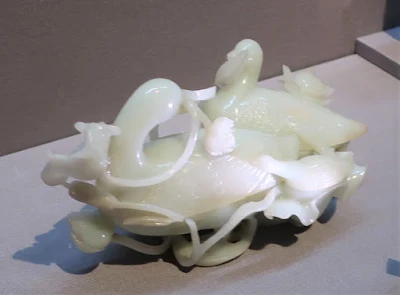This is a box in the shape of waterfowl at Tokyo National Museum, carved from white jade in the 19th century in the Qing dynasty period.
 |
| Box in shape of waterfowl, 19th century, Qing dynasty 白玉水禽形合子 清時代 |
 |
| Made from white jade 白玉製 |
Male and female waterfowl represent "a loving couple" while chicks and lotus flowers "family prosperity" in China. On top of that, the box also represents "love" since "lotus" is pronounced the same as "love." Difficult to decipher the message but no worries. You can enjoy this beautiful sculpture without knowing it!
China has a long history of crafting fine objects from jade and other gemstones while maximizing their original colors, and Japan calls such objects "shoshoku sculptures."
For other shoshoku sculptures carved from various stones in the Qing dynasty period, read the following, too:
- Qing Dynasty Sculptures (jade incense burner, amethyst grapes, and agate pomegranates)
(If you wish to post your comment but don't have a Google account, select "anonymous" from the drop down menu titled "comment as"!)
東京国立博物館の白玉水禽形合子です。「俏色工芸」という石の特性を生かした工芸で、雌雄の水鳥は夫婦相愛を、雛鳥と蓮は子孫繁栄を意味し、蓮と恋は同音なので恋愛も象徴するとのこと。隠されたメッセージがたっぷりです。でもたとえメッセージが分からなくても十分楽しめる美しくカワイイ彫刻だと思いませんか?
俏色工芸にご興味ある方は以下の記事もどうぞお読みください!
(Google アカウントを持ってない方は、コメント記入後に「Google アカウント」をクリックし、「匿名」か「名前/URL」を選択してからご記入ください!)


0 件のコメント:
コメントを投稿